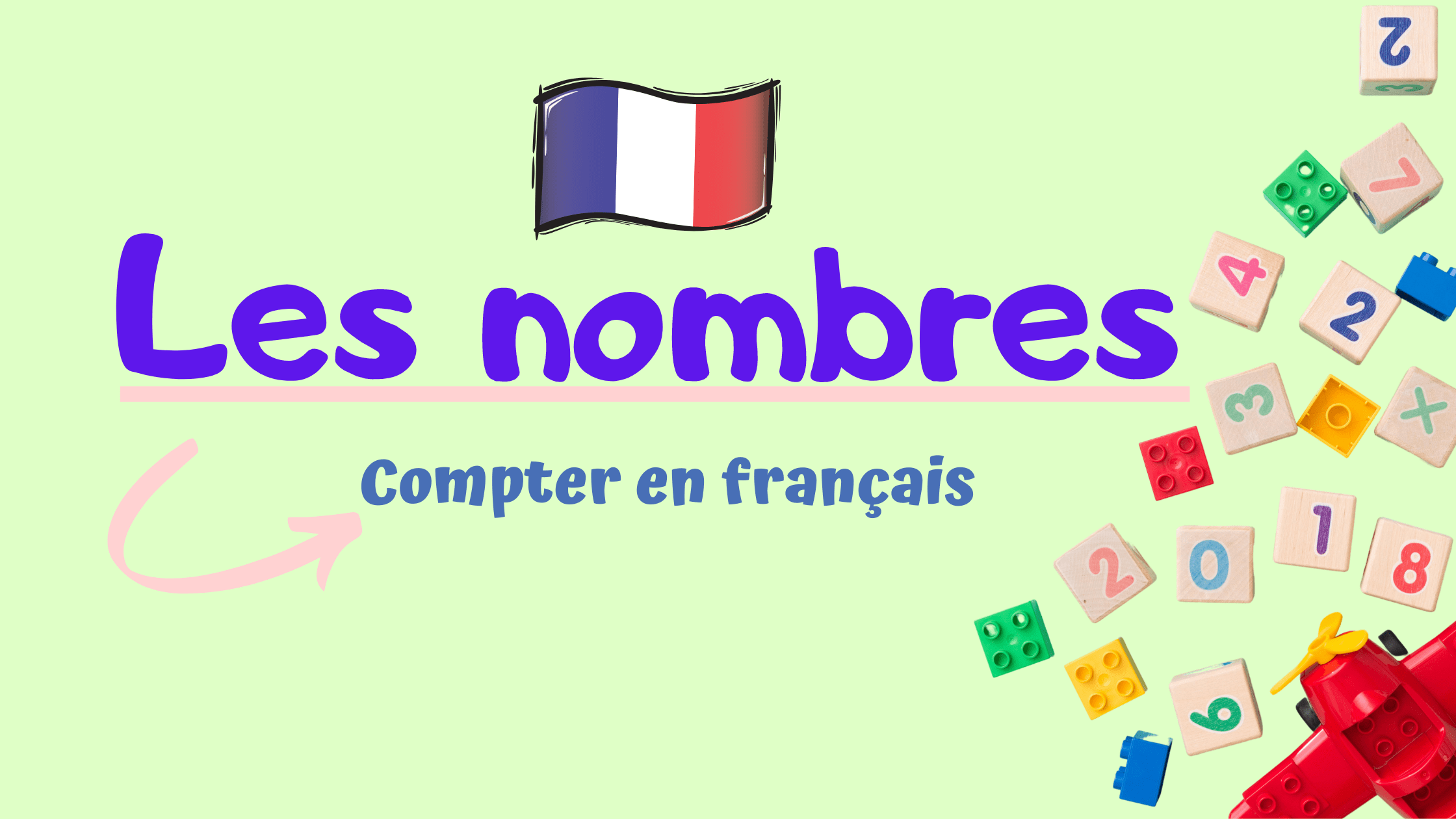Bonjour à toutes et à tous! Aujourd’hui, nous allons apprendre à compter en français. Today, we are going to learn how to count in French. Numbers in French can be very confusing for beginners, as the counting pattern in French (from France) changes. Why would it be so confusing, numbers are numbers, right?
Well… in French, it’s not as simple as that. Numbers in French are… math!
Are you ready? Trois, deux, un… Let’s learn how to count in French!
Listen to podcast
How to count in French : 1-10
- Un (1)
- Deux (2)
- Trois (3)
- Quatre (4)
- Cinq (5)
- Six (6)
- Sept (7)
- Huit (8)
- Neuf (9)
- Dix (10)
The numbers above are called independent numbers.
11-20
To count in French from 11 to 20, this is how you spell the numbers:
- Onze (11)
- Douze (12)
- Treize (13)
- Quatorze (14)
- Quinze (15)
- Seize (16)
- Dix-sept (17)
- Dix-huit (18)
- Dix-neuf (19)
- Vingt (20)
Now from what we see right above, the numbers from 11 up to 20 are using independent numbers but also composed numbers, such as :
- Dix-sept (literally ten seven)
- Dix-huit (literally ten eight)
- Dix-neuf (literally ten nine)
20 – 69
This is when things get a little bit more complicated, but please stay with me here. Counting in French will require using patterns. For example, from 20 all the way up to 60, numbers will follow the exact same pattern of counting, which is :
- Vingt (20)
- Trente (30)
- Quarante (40)
- Cinquante (50)
- Soixante (60)
And what about in between?
- Vingt (20)
- Vingt-et-un (21)
- Vingt-deux (22)
- Vingt-trois (23)
- Vingt-quatre (24) …
- Trente (30)
- Trente-et-un (31)
- Trente-deux (32)
- Trente-trois (33) …
For 21, 31, 41, 51, 61, you will need to add “et” (and) between the tens and “un” :
- Vingt-et-un
- Trente-et-un
- Quarante-et-un …
- Vingt-deux
- Trente-trois …
Count in French from 20 to 69 (Table)
| 20 | vingt | 30 | trente | 40 | quarante | 50 | cinquante | 60 | soixante |
| 21 | vingt et un | 31 | trente et un | 41 | quarante et un | 51 | cinquante et un | 61 | soixante et un |
| 22 | vingt-deux | 32 | trente-deux | 42 | quarante-deux | 52 | cinquante-deux | 62 | soixante-deux |
| 23 | vingt-trois | 33 | trente-trois | 43 | quarante-trois | 53 | cinquante-trois | 63 | soixante-trois |
| 24 | vingt-quatre | 34 | trente-quatre | 44 | quarante-quatre | 54 | cinquante-quatre | 64 | soixante-quatre |
| 25 | vingt-cinq | 35 | trente-cinq | 45 | quarante-cinq | 55 | cinquante-cinq | 65 | soixante-cinq |
| 26 | vingt-six | 36 | trente-six | 46 | quarante-six | 56 | cinquante-six | 66 | soixante-six |
| 27 | vingt-sept | 37 | trente-sept | 47 | quarante-sept | 57 | cinquante-sept | 67 | soixante-sept |
| 28 | vingt-huit | 38 | trente-huit | 48 | quarante-huit | 58 | cinquante-huit | 68 | soixante-huit |
| 29 | vingt-neuf | 39 | trente-neuf | 49 | quarante-neuf | 59 | cinquante-neuf | 69 | soixante-neuf |
After 69 …
Now, after 69, the pattern will suddenly change. This is how you count in French from 70 and up.
For 70, 80 and 90 :
- Soixante-dix (Sixty-ten 60 +10)
- Quatre-vingts* (Four Twenty 4 x 20)
- Quatre-vingt-dix (Four Twenty Ten 4 x 20 + 10)
Numbers | FR | EN (lit.) |
70 | Soixante-dix | Sixty-ten |
71 | Soixante-et-onze | Sixty-and-eleven |
72 | Soixante-douze | Sixty-twelve |
73 | Soixante-treize | Sixty-thirteen |
74 | Soixante-quatorze | Sixty-fourteen |
75 | Soixante-quinze | Sixty-fifteen |
76 | Soixante-seize | Sixty-sixteen |
77 | Soixante-dix-sept | Sixty-ten-seven |
78 | Soixante-dix-huit | Sixty-ten-eight |
79 | Soixante-dix-neuf | Sixty-ten-nine |
80 | Quatre-vingts | Four-twenties |
81 | Quatre-vingt-un | Four-twenty-one (do not add “et“) |
82 | Quatre-vingt-deux | Four-twenty-two |
83 | Quatre-vingt-trois | Four-twenty-three |
84 | Quatre-vingt-quatre | Four-twenty-four |
85 | Quatre-vingt-cinq | Four-twenty-five |
86 | Quatre-vingt-six | Four twenty-six |
87 | Quatre-vingt-sept | Four-twenty-seven |
88 | Quatre-vingt-huit | Four-twenty-eight |
89 | Quatre-vingt-neuf | Four-twenty-nine |
90 | Quatre-vingt-dix | Four-twenty-ten |
91 | Quatre-vingt-onze | Four-twenty-eleven (do not add “et”) |
92 | Quatre-vingt-douze | Four-twenty-twelve |
93 | Quatre-vingt-treize | Four-twenty-thirteen |
94 | Quatre-vingt-quatorze | Four-twenty-fourteen |
95 | Quatre-vingt-quinze | Four-twenty-fifteen |
96 | Quatre-vingt-seize | Four-twenty-sixteen |
97 | Quatre-vingt-dix-sept | Four-twenty-ten-seven |
98 | Quatre-vingt-dix-huit | Four-twenty-ten-eight |
99 | Quatre-vingt-dix-neuf | Four-twenty-ten-nine |
100 | Cent | One hundred |
So if you were to say 99 in French, it would be as if you were saying “Four twenty-ten-nine”. How original is that?
One thing that you need to remember with these counting patterns in French, is:
From 20 – 60 : You count by tens. You stop after “…-neuf” and start with another number.
From 60 – 100 : You count by twenties. You stop after “… dix-neuf” and start with another number.
After 100
Here’s a quick table for you :
100 | Cent |
1000 | Mille |
10 000 | Dix-mille |
100 000 | Cent-mille |
1 000 000 | Un million |
1 000 000 000 | Un milliard |
Numbers after 100 are simply classic composed numbers. You will read them as you see them come :
- 200 = Deux-cents*
- 250 = Deux-cent-cinquante
- 253 = Deux-cent-cinquante-trois
* For 200, the same rule as 80 applies : the “s” is only kept when it’s not followed by any other numeral.
Cent-quarante-deux / Deux-mille-vingt / Douze-mille-quatre-cents / Mille-neuf-cent-cinquante-deux.
Parfait ! Now let’s spell these numbers in letters:
156 / 354 / 2300 / 278 / 3682 / 45 920.
Maybe that last one was a though one, right? Don’t panic! The answers will be at the end of the article.
Fun fact : Did you know that in French-speaking Belgium and in Switzerland, they don’t use “Soixante-dix”, “Quatre-vingts” and “Quatre-vingt-dix”?
They will simply follow the usual pattern (which is from 20 to 60) :
- Septante (70)
- Octante or Huitante (80)
- Nonante (90)
Count in French : Conclusion
Et voilà! You now know how to count in French. I hope you enjoyed this little lesson and that you are looking forward to more knowledge about the French language, I know I am looking forward to write more content for you guys. Please share your thoughts in the comments down below, what do you find the hardest in learning how to count in French? Let me know!
Oh, and by the way, here are the answers to the 2 mini exercises :
1. 142 / 2020 / 12 400 / 1952
2. Cent-cinquante-six / Trois-cent-cinquante-quatre / Deux-mille-trois-cents / Deux-cent-soixante-dix-huit / Trois-mille-six-cent-quatre-vingt-deux / Quarante-cinq-mille-neuf-cent-vingt
For more articles and lessons for beginners, click here.
Feel free to join my Facebook community (see below), or to subscribe to my YouTube channel right here (Learn To French on YouTube) for more lessons and content about learning French!
Until the next lesson, I will say merci beaucoup et à bientôt sur Learn To French!








